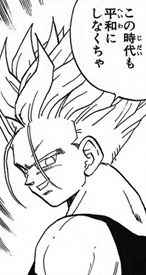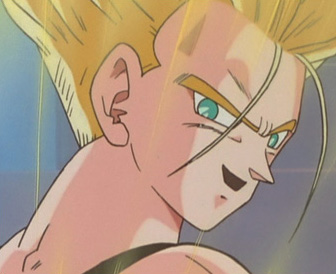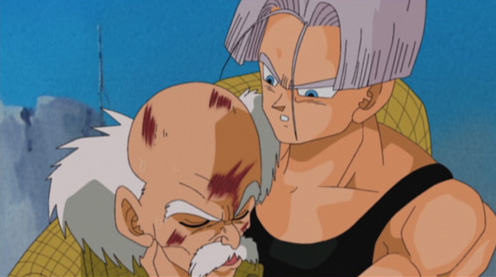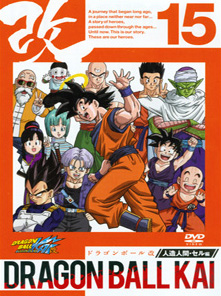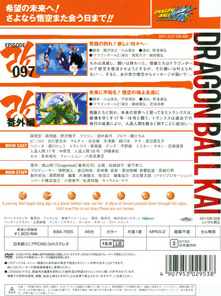Dragon Ball Kai had a production and release history far more complicated than it perhaps should have needed or deserved. A crash course for the purpose of reviewing it may be necessary, one we would normally promise would be even shorter than when we reviewed the first Blu-ray release… but too much has happened since then that needs to be clarified!
In early 2009 we learned that in celebration of the 20th anniversary of Dragon Ball Z, the series would be receiving a “refreshed” treatment for television. It would be a condensed, newly voice acted (though primarily with the same cast), and newly scored version of the series using the exact same footage from twenty years prior. There are occasional newly-animated scenes, though they are essentially traced on top of the existing footage (either to replace damaged film, to “enhance” the special effects, or for any variety of reasons we still have yet to comprehend, even after its conclusion).
The “refreshed” series began airing 05 April 2009. Interestingly, the series was broadcast in a cropped 16:9 aspect ratio. Despite being “remastered” and cleaned-up for a high definition broadcast, only the Blu-ray release received a proper aspect ratio in Japan — the TV broadcast and (curiously) the DVD release are both cropped.
During what appeared to be a rocky and haphazard production, the series was ultimately scheduled for what many consider a premature end. It was announced that Kai would conclude after 98 episodes, wrapping things up with the Cell Game and Trunks’ return to his future timeline (it is worth noting that it was never actually stated that the series would be exactly or even around “99 episodes” despite early rumors). Unfortunately, events beyond the control of even the production team would knock that number down one when tragedy struck Japan in March 2011. The “final” episode of the series never saw the light of day on television, and with Toriko still scheduled to begin in its prior time slot on 03 April 2011, it was up in the air as to what would happen with that material.
Additionally, with only two episodes left to air (technically three counting “Episode 98”), Toei announced out of nowhere that they were investigating potentially “infringing” tracks within the series’ musical score. Episodes 96 and 97 would air with an entire musical score ripped from Shunsuke Kikuchi’s original musical score for Dragon Ball Z, and the rest of the series would be retroactively re-scored with this same music. The final two Blu-ray sets in Japan would contain this replacement score, as well as the final nine individual DVDs.
All of that brings us to this: the final Japanese DVD release for the “refreshed” series. The way the episodes worked out, it potentially left a final volume with only a single episode. Would “Episode 98” see the light of day at all? Thankfully, it was quietly announced in May 2011 that the final Blu-ray set and DVD would indeed include the episode, now listed as a bangai hen (or “bonus” episode/chapter) instead of one with a proper number.
Quick Details:
| JAN: | 4907953029538 |
| Publisher: | Happinet |
| Release Date: | 02 August 2011 |
| MSRP: | ¥1995 |
| Format: | DVD (Region 2) |
| Contents: | Dragon Ball Kai Episodes 97 + Bonus (“98”) |
The review of this DVD was made possible by your referral purchases on CDJapan. If you are interested in contributing to the site, please visit our “Donate” page.
Review By: Mike LaBrie (VegettoEX)
After concluding the Saiyan and Freeza story arcs, Happinet re-classified the rest of the series under the “Artificial Humans & Cell Arc” subtitle, also rebooting the volume numbering on both the DVD and Blu-ray side. While the final volume is listed as “Volume 15” in this arc, it is technically the 33rd total volume in the series — in fact, the disc’s volume naming when viewed on a computer is a full “DRAGON_BALL_KAI_33”.
Content:
We have spoken at length about Dragon Ball Kai on our podcast. With the conclusion of the Saiyan arc, our roundtable discussion basically ended with the same conclusion from all the hosts and guests: it was a neat novelty at first, but it felt very rough, rushed, and just a strange way to celebrate twenty years of DBZ. The vocal performances were all sufficient if not equal to the originals, and even the few cast replacements that were necessary (Hikaru Midorikawa as Tenshinhan) seemed to work out. The music was interesting and overall felt mostly at-home with the series coming from veteran Kenji Yamamoto, but still had some missing element that really secured its place as a true score for the series in the eyes of many fans. In the end, we all simply lost interest in Kai, and rarely kept up with it after this point.
As things headed into the Cell arc, we popped back over to the series from time to time. The occasional new insert song kept us music fans happy, Yamamoto waking up every so often to compose a new track or two helped keep things fresh in the background, and comparing performances by veterans like Norio Wakamoto (Cell) is always a good time. Once the music fiasco hit right before the series ended, it made everything simultaneously fun, strange, and groan-worthy in a car crash sort of way.
We had actually checked out the final episode after its broadcast, and between the original manga and TV versions of the story, it was not as if the content was foreign to us. How did it all come together in this Kai-ified version, though?
Episode 97
笑顔の別れ!新しい日々へ…
Egao no Wakare! Atarashī Hibi e…
Farewell With a Smile! Heading for New Days…
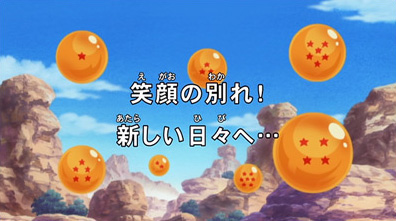
After the battle with Cell has concluded (and the true heroes have departed), the only one left standing is Mr. Satan, who is thereby deemed the champion! Gohan is healed back to normal by Dende, and #18 rushes off after berating poor Kuririn. Shenlong is summoned to wish those killed by the Artificial Humans and Cell back to life, including Trunks. Next up is a wish to bring Goku back to life, but (speaking through Kaiō-sama), he decides to stay dead. Wondering what else to wish for, unable to turn #18 into a human (as a cyborg, she is already human-based to begin with…), a wish is made to remove the bomb within her (as well as within #17). The heroes say their goodbyes to each other and return to wherever their hearts take them. Gohan is seemingly now the true hero of Earth!
Episode 97 of Kai takes material from the original Dragon Ball Z episodes 192 (basically the entire episode) and 193 (from the beginning up until about halfway through). A little bit of Mr. Satan footage, some extraneous Goku material, and other bits here and there are lopped off to create a pretty standard Kai episode.
Veteran voice actor Daisuke Gōri unfortunately passed away before the “refreshed” series reached Mr. Satan, so the role was ultimately replaced with (newcomer for the franchise) Unshō Ishizuka. He plays the character well enough and as believable as one could probably expect, but the loss of Gōri is simply immeasurable.
Shortly after its original television broadcast, many fans voiced their distaste toward “Dragon Soul”, the opening theme to the “refreshed” series, being used as a musical ending to the episode, which included brief footage of Gohan consoling Chi-Chi (after hearing about, of course, Goku’s death in the battle against Cell). From our perspective, it fits perfectly fine. It is certainly a different take on the scene than its original Dragon Ball Z version (which used the foreboding track from DBZ Movie 7 as #13 whacks away at Goku), but in the context with the rest of the footage and set-up of the “end” of the show, we have no real complaints.
Episode 97 is an interesting one — taken by itself, it is a perfectly “normal” episode. As an ending to the series? That is up to you. We know that if Toriyama was looking to end the series, the Cell arc was likely not at the top of his list in terms of a time or place to do so (or at least not more so than other parts of the series). It does wrap up a few loose ends and transfers the focus to Gohan, seemingly bringing things to where Toriyama had been writing his way toward ever since the Saiyan arc.
Bonus Episode
未来に平和を!悟空の魂よ永遠に
Mirai ni Heiwa o! Gokū no Tamashī yo Eien ni
Bring Peace to the Future! Goku’s Spirit is Eternal
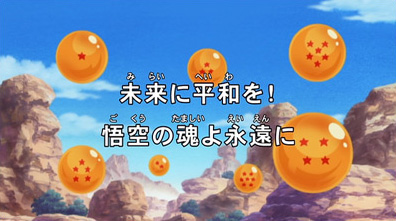
Gohan has returned home, and is out catching a fish for a meal. Mr. Satan is parading around with the media showcasing his incredible strength. Goku is hanging out with Kaiō-sama somewhere along the Serpent Road, laughing down below at Mr. Satan’s antics. In his future time, Trunks has returned and spends some time with his mother, recounting his experience in the past and particularly with his father, Vegeta. News comes via radio that the Artificial Humans are attacking again, and so Trunks flies off to take care of them for good. #18 unleashes her power on what remains of a city, while #17 smirks as he prepares to murder an old man who shot at him. Trunks arrives just in time to save him, and finishes off with #18 with a single blast. #17 tries to fight back, but after a kick, he gets blasted to smithereens, as well. Trunks knows that this is not over, though. The time machine has recharged and Trunks is ready to return to past to report that he has destroyed the Artificial Humans in his own time. He feels the power of the remaining evil, though, and orders his mother inside. Cell has come for him! Trunks knows that Cell is here to kill him and steal the time machine, but he is more than prepared. Trunks blasts Cell off into the distance for a short battle. In the end, Cell in his first-form is nothing for Trunks, who has now finally saved his future from any more of Dr. Gero’s evil creations. Back in the present, Goku accidentally destroys the small shack Kaiō-sama had put together. The episode closes out with a musical montage showcasing Goku’s battles in the Ano-yo’ichi Budōkai, and scenes from the entire run of Dragon Ball Kai.
The “bonus episode” of Kai takes material from the original Dragon Ball Z episodes 193 (a little over halfway in) and 194 (most of the episode). It is pretty effortlessly edited together, keeping up with the flow of the scenes’ original pacing quite well by simply removing the occasional cut-away scene that pops up in the middle of longer scenes.
Trunks is the real star of this episode, returning to his semi-destroyed future time to put an end to the evil. Unfortunately, this was always an episode plagued by off-model character designs and poor animation (courtesy of animation studio “Last House” and Masayuki Uchiyama) — the simple remastering in Kai cannot save it from itself in that respect. While it is a joy to have Toriyama see things through to the end for this Trunks’ story, the TV adaptation unfortunately sours the experience a bit, even over here in the “refreshed” version.
While we checked in on the “Artificial Humans & Cell arc” very rarely during its initial Japanese broadcast, we heard rumblings that Norio Wakamoto had changed his performance, specifically of first-form Cell. Indeed, here in his final Kai appearance (discounting filler material in the Boo story arc and eventually in Dragon Ball GT), the exaggerated, drawn-out noises that made us shudder in the 1990s have been replaced by strange moanings and chirps (and entirely different exaggerated, drawn-out noises) in 2011. It is certainly an interesting take on the form, but not necessarily a change for the better. Takeshi Kusao, on the other hand, plays Trunks as convincingly as ever.
(Norio Wakamoto as first-form Cell: original Z versus Kai)
What would have been one of only three episodes left to broadcast after the music scandal went down (and ultimately kicked off the broadcast schedule and relegated to only the home release), the “bonus” episode draws heavily from DBZ Movie 8’s score, originally used more often during the Majin Boo story arc in the Dragon Ball Z TV series. It certainly fits here, but we of course missed some of our favorite musical cues from the original version of the episode (though interestingly, some were exactly the same as their “Z” counterparts, such as the BGM in the sound clip showcased above). Somewhat surprisingly, the episode also contained the final insert song for the series: “CURE ~ Boku ga Koko ni Iru yo ~” (“CURE ~ I’ll Be Here ~”), performed in-character as Dende by voice actress Aya Hirano. We actually missed it the first time through the episode, tipped off by its inclusion in the final credits. The song plays faintly in the background on the radio and Trunks and Bulma talk right before the announcer comes on to speak about #17 and #18’s latest reign of terror. It was certainly a way to get some extra usage out of the song which has otherwise been sitting on soundtracks for the series for almost two years — the “in the background on the radio” technique was previously used in Kai back on episode 85 to play “My 18th Magic”.
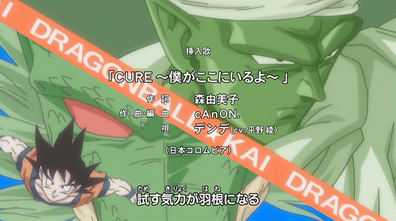
Perhaps the most worthwhile reason to check out the “extra” Kai episode was the musical montage at the end. With no Majin Boo story arc on the horizon, exactly what would they do to wrap things up, especially considering that episode 97 already wrapped things up in its own way? Strangely, the two-minute extended “Dragon Soul” vocal song begins with a glimpse at the Ano-yo’ichi Budōkai before moving into a recap of the rest of the series… which then somewhat starts over yet again, focusing on different events than it did the first time through. It was very reminiscent of the montage at the end of Dragon Ball GT episode 64, which seemed to have no real rhyme or reason to the order of events it chose to highlight. It fit and it works here at the end of the episode, but was very amateurish work.
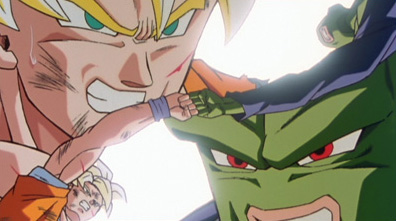
The inclusion of the afterlife tournament scenes is the most perplexing part, though. What purpose does it serve? Considering the fillerific Garlic Jr. mini-arc was completely excised from Kai, what reason is there to acknowledge this one (which is half the length of the former)? Is it just to show that Goku is up to his usual antics and everything is fine? It almost flies in the face of the ending, though, showcasing how Gohan has taken over the reigns. If the viewer did not know this tiny arc came next in the story (indeed, part of the point of Kai was to indoctrinate a younger audience for future potential marketing), how on Earth would they be able to place these quick shots in context with what is otherwise a recap…?
Does “Episode 98” work as a better ending to the series than the previous episode? In their Kai incarnations, since both have a musical montage to close things out (not to mention with the same song each time), it really is a toss-up. In terms of tone, the prior episode probably works better. In terms of story wrap-up, the “bonus” episode probably works better. Do we actually need to know how Trunks took care of his future, though? Much in the way that DBZ Movie 9 branches off and apparently showcases Trunks coming back to say how he has destroyed the Artificial Humans in his time (as he was about to do right before encountering Cell), perhaps that is best suited to a spin-off, be it a movie or a TV special, rather than directly in the series. It was in the manga, though, so do you keep it here for purity’s sake? The episode was always a strange one to begin with; perhaps it was a case of Toriyama not being as comfortable with the “serious” side of story-telling that he has expressed in the past?
Presentation:
Dragon Ball Kai basically looks as good as any finely-tuned, weekly-produced animation from 1989 through 1996 is going to get. Existing footage has been color-corrected in a few areas and upscaled to high-definition when the base, original footage is used. Re-animated scenes (few and far between in the grand scheme of things) are essentially just re-traced scenes on top of the original animation, and run the gamut from sticking out like a sore thumb to blending in perfectly and enhancing the original material. The re-animated scenes stick out far less in standard definition than they do on the Blu-ray release, but are still noticeable.
The footage is what it is, though, and any gripes with its production were aired during the show’s original broadcast on television. By now it is clear what you are getting in terms of the footage itself, so any real analysis should be done with the packaging and technical details, themselves.
Sadly, the DVD release of the series in Japan has been a cropped 16:9 from the beginning (despite the Blu-ray release being presented in its originally-produced high-definition 4:3). This was a ridiculous decision, and the series feels as cramped as ever when the top and bottom are needlessly chopped off.
Video encoding seems to be set on automatic, but looks quite nice considering the lack of effort necessary to put into it. With only two episodes on the single-layered disc, the progressively-encoded episodes hover around the 8 Mbps range quite often, essentially maxing out what the now-old DVD format can do.
That being said, the Japanese DVD release does have a few issues. The coloring and even the encoding have been stated to be notoriously half-assed at times. Have things changed, especially since the first volume in 2009? In a way, yes. The coloring appears to be slightly darker, but the same edge enhancement resulting in some shimmering along the edges is still present, at least in the opening theme (and actually worse in some areas, such as around the chin):
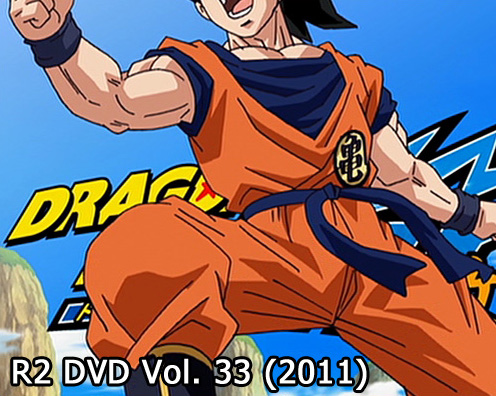
It is an incredibly minor issue, but it is still there two years later, and is at least worth pointing out. Thankfully, the edges in the actual episodes’ content themselves are far softer.
There are no subtitles for any language on this Japanese release. The single audio inclusion is a bare-bones stereo track. Everything is crystal clear thanks to the modern voice recording and music production, which can act as a stark contrast to the footage at times. The single audio track is encoded as straight-up PCM.
Packaging:
The final DVD volume comes in the standard plastic case that the entire run of the previous R2 single disc releases came in, opening on the right side. The front cover harkens back to the classic Goku-with-wings pose from the second Dragon Ball Z TV closing theme (“Boku-tachi wa Tenshi Datta”), overtop a fun collage of other characters. The back cover is a well-organized listing of the two episodes, which contains the episode titles, original air dates, descriptions, and a corresponding screen shot from each. The cast and staff are listed in the middle area, while the bottom details all of the technical information for the disc.
What is somewhat nice about the case is that it can actually hold two discs on top of each other, snapped into place, with no rattling around. Since we like to keep our own region-less copies of the discs available, it worked out perfectly to stack our cheap re-burn on top of the original pressed disc, keeping things as scratch-free as can be.
All in all, a pretty standard style of packaging — nothing more, nothing less expected.
The Extra Stuff:
There is absolutely no bonus material included with this disc, apart from the 98th episode if you want to consider that a “bonus”.
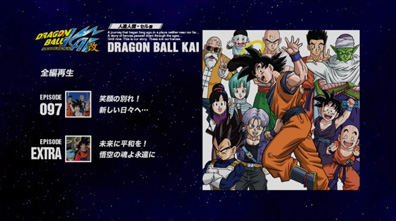
There are no on-disc presentations beyond the two episodes themselves (no creditless opening and ending, for example), and the packaging does not include any extra cards or trinkets.
Final Thoughts:
In all honesty, the only reason most folks will have for picking up the final Japanese DVD release will be to check out the “bonus” 98th episode. The price helps, too — at a reduced ¥1995, it is not an expensive buy-in. At the same time, there are a mere two episodes on the disc, with absolutely zilch beyond them. Toss in the cropped video, and you really have to make the tough call for yourself, especially considering that it will likely end up on the North American release sometime soon down the road (remember, the Japanese DVD is Region 2). With the entire rest of the world shifting to the Shunsuke Kikuchi replacement score (which is right there on the Dragon Box version of the episodes if you want to go that route), it is not as if even the Japanese release has an optional Kenji Yamamoto soundtrack available in the background to give it an edge if that is where your preferences have shifted.
Dragon Ball Kai is produced by Toei Animation and released to DVD and Blu-ray by Happinet. Volume 33 DVD: MSRP ¥1995, released 02 August 2011, contains two episodes. Entire disc viewed.
Purchase This Item:
Dragon Ball Kai (DVD) Artificial Human & Cell Arc #15 (Overall Volume 33) may be available at the following online retailers:







